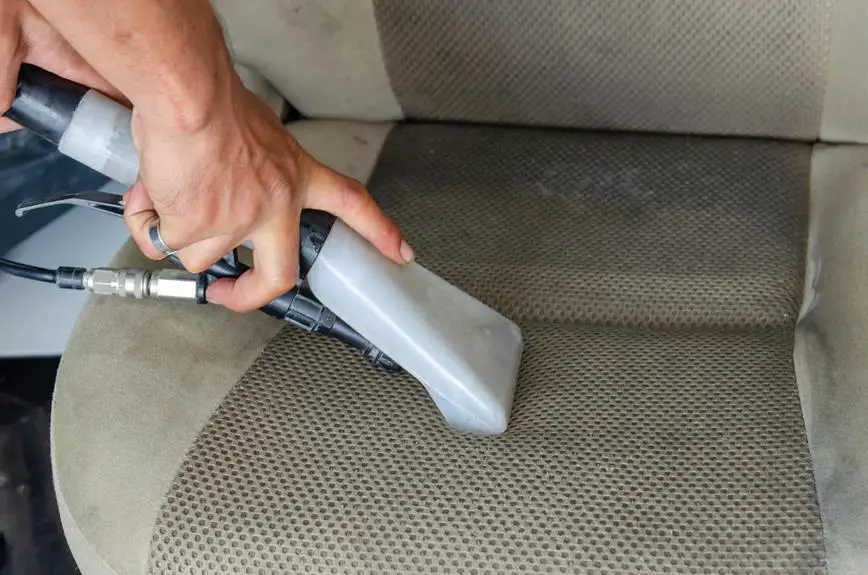When you're faced with a stain on pinpoint fabric, it's crucial to act swiftly and carefully. Start by gently blotting the area to absorb any excess liquid, but don't rub, as that can make it worse. Knowing the type of stain is essential, since each requires a different approach. For instance, did you know that dish soap works wonders on oil-based stains? But there's more to consider, including specific cleaning methods and preventative measures. Understanding these nuances can save your fabric, and you might be surprised by what you discover next.
Table of Contents
Understanding Pinpoint Fabric
Pinpoint fabric, characterized by its fine texture and durability, requires special care to maintain its appearance and longevity. As you handle pinpoint, you'll notice its tightly woven structure that adds to its elegant look while also making it susceptible to wear if not treated properly. You'll want to be cautious with how you wash and dry it.
When laundering, always check the label for specific instructions. Opt for a gentle cycle with cold water to prevent shrinking and fading. Using a mild detergent will help preserve the fabric's integrity without causing damage. Avoid bleach at all costs, as it can severely affect the color and texture.
Ironing pinpoint fabric may also require extra attention. Use a low heat setting, and consider placing a thin cloth between the iron and the fabric to avoid direct contact. This way, you can prevent potential scorch marks.
Regularly inspect your pinpoint clothing for any signs of wear or damage. By staying proactive, you can ensure your garments remain in excellent condition, ready for any occasion. Taking these steps will help you enjoy your pinpoint pieces for years to come.
Common Types of Stains
Understanding the types of stains that commonly affect fabrics like pinpoint can help you tackle them effectively and maintain your clothing's pristine condition. One of the most frequent offenders is food stains. Whether it's sauce, grease, or wine, these can quickly mar your fabric if not treated promptly.
Another common stain is ink, which can happen from pens or markers. Ink stains can be particularly stubborn, but knowing how to address them early can save your shirt.
Then there are sweat stains, which can develop around the underarms, especially in warmer weather. These not only affect the fabric but can also leave behind unpleasant odors.
Additionally, dirt and mud stains are prevalent for those who enjoy outdoor activities. If you're a parent, you might also encounter grass stains, which can be tricky to remove.
Lastly, oil stains from cosmetics or skincare products can also affect pinpoint fabric. Each of these stains requires a specific approach, so being aware of them helps you prepare and act quickly when accidents happen.
Recognizing these common culprits is the first step in protecting your pinpoint fabric from lasting damage.
Pre-Treatment Techniques
Before tackling any stain on your pinpoint fabric, it's crucial to pre-treat it properly to increase your chances of successful removal.
Start by gently blotting the stain with a clean, dry cloth to absorb any excess liquid. Avoid rubbing, as this can push the stain deeper into the fibers.
Next, identify the type of stain you're dealing with. Different stains require different approaches. For example, if it's a grease stain, sprinkle some cornstarch or talcum powder on it to absorb the oil. Let it sit for about 15 minutes before brushing it off gently.
For protein-based stains, like blood or sweat, cold water is your best friend. Rinse the area with cold water to help lift the stain before applying a suitable pre-treatment solution.
For other stains, consider using a stain remover or a mixture of dish soap and water. Apply the solution directly to the stain and let it sit for 5 to 10 minutes.
Always test any pre-treatment solution on a hidden area first to avoid damaging the fabric.
After pre-treating, you'll be better equipped to proceed with the cleaning methods tailored for your stain.
Cleaning Methods for Stains
Once you've pre-treated the stain, it's time to explore effective cleaning methods tailored to tackle specific types of stains on your pinpoint fabric. Each stain type requires a different approach, so knowing how to handle them can save your favorite pieces.
Here are some cleaning methods you can use:
- Oil-based stains: Blot the area with a clean cloth and apply a small amount of dish soap. Let it sit for 10 minutes before rinsing with warm water.
- Water-based stains: Rinse the fabric under cold water immediately, then apply a gentle fabric cleaner.
- Ink stains: Dab the stain with rubbing alcohol on a cotton ball, then blot with a clean cloth until the ink lifts.
- Blood stains: Use cold water to rinse, then apply hydrogen peroxide directly on the stain. Blot until the stain is gone.
Make sure to test any cleaning solution on a hidden area first to ensure it won't damage your fabric.
Preventing Future Stains
To keep your pinpoint fabric looking fresh and stain-free, adopting a few preventive measures can make all the difference. First, consider using a fabric protector spray. This creates a barrier against spills and stains, making it easier to wipe away any mishaps before they set in.
When you wear pinpoint fabric, avoid high-risk activities, especially around food and drinks. If you know you're having a meal, opt for a darker outfit or a bib-style apron to catch any potential spills.
Another effective strategy is to wash your pinpoint items regularly. Dirt and oils can accumulate over time, increasing the chances of staining. Follow the care instructions carefully, and always wash with similar colors to prevent dye transfer.
Lastly, be mindful of where you store your pinpoint fabric. Keep it away from areas where it might be exposed to potential stains, like a cluttered desk or a kitchen counter.
With these simple steps, you'll minimize the risk of future stains and keep your pinpoint fabric looking its best for longer.
Frequently Asked Questions
Can I Use Bleach on Pinpoint Fabric Stains?
You shouldn't use bleach on pinpoint fabric stains. It can damage the fibers and lead to discoloration. Instead, try mild detergents or specialized stain removers designed for delicate fabrics to effectively tackle those stains.
How Do I Test for Colorfastness on Pinpoint?
To test for colorfastness on pinpoint fabric, dampen a hidden area with water and blot it with a white cloth. If color transfers, it's not colorfast, and you should proceed with caution when cleaning.
What Tools Are Best for Removing Pinpoint Stains?
To tackle stains effectively, you'll need a few essential tools. Grab a soft brush, clean cloths, gentle detergent, and possibly a stain remover. These will help you lift those stubborn marks without damaging the fabric.
Are There Specific Detergents Recommended for Pinpoint Fabric?
When choosing detergents for pinpoint fabric, look for ones labeled as gentle or delicate. They'll help preserve the fabric's integrity while effectively cleaning. Always check the care label for specific recommendations to avoid damage.
Can I Machine Wash Pinpoint Fabric After Stain Removal?
Yes, you can machine wash pinpoint fabric after stain removal. Just ensure you've properly treated the stains first, and use a gentle cycle with cold water to maintain the fabric's integrity and prevent damage.
- Tetron Fabric for Marine Applications: Durability and Use Cases - June 18, 2025
- Tetron Fabric for Outdoor Furniture: Weather Resistance and Care - June 18, 2025
- Tetron Fabric for Wall Coverings: Style and Application Tips - June 18, 2025







